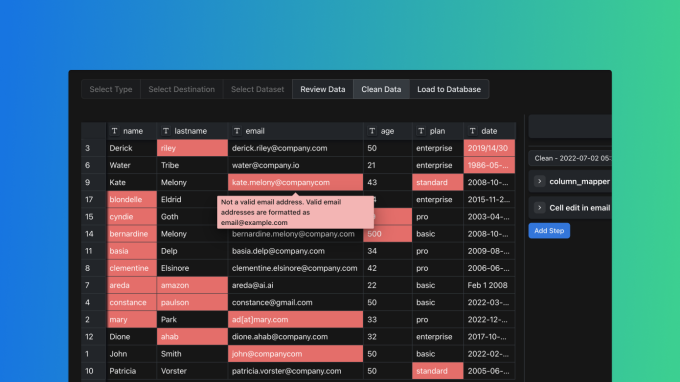It’s not unusual for a tech company to be born by accident. Famously, Slack was created as a byproduct of a now defunct gaming company. Similarly, when Dropbase founders Jimmy Chan and Ayazhan Zhakhan were in the Y Combinator Winter 20 batch, they were testing the product they had built at the time and accidentally stumbled upon the thing that would become Dropbase.
The two founders were struggling to move spreadsheet data into a SQL database where they could work with it. Even though they were technical people, they couldn’t get everything working without a lot of tinkering. They created a tool to make it easy to drag and drop a .csv file onto a Postgres database and start querying it.
Chan says it was kind of a eureka moment for them, as they realized that if they were having trouble doing this, a lot of other people would be too, and they shifted gears to create Dropbase.
“We were thinking that there should be an easier way to just do it. I just want to drag and drop a .csv file into a SQL database directly. And that’s when we came up with the name Dropbase, because you can drag it into a Postgres database, and we just give you credentials for the database and so you would just instantly have access to that .csv file in your hosted cloud database. So that’s how we started with this,” Chan told TechCrunch.
They had to overcome some big obstacles that anyone who works with data would be familiar with such as reconciling differences in the same data that can confuse a conversion filter. “After you drag and drop a .csv file, there’s usually still a lot of issues with the file. Sometimes different parts of the world encode .csv files differently. For instance, in France, they use semicolons instead of commas. And so firstly, we do inference. We look at a sample of the data and we try to guess what’s the best way to open the file,” he said.
He said, another issue is that the data isn’t always in the format you expect it to be in the table, so how do you get it consistent? They came up with the notion of checks to make sure that the data is in the right format to get past the conversion filters, but Chan says these go beyond simple syntactic checks.

Image Credits: Dropbase
“They’re actually semantic checks. So what I mean by that is that we’re not just checking whether your postal code is of a certain format, but we can check whether your dates are within a given range, or they’re after a certain time or before a certain time, or if your numbers should be a minimum of something. So it’s a little bit more [sophisticated] checking,” he explained.
He says that once they show the user the issues, they can clean up any remaining problems, and then load the database and it’s available for querying in SQL. “The advantages of having data in a SQL database is that you can quickly query it. That’s the first thing. The second thing is that you can connect it to a downstream tool like a BI tool or another data tool in a more easy way. And you can build more historical datasets over time,” he said.
More recent features in the product include a new tool called Dropmail, which enables users to email a .csv file to turn it into a SQL database, and the ability to host your own data with Snowflake integration.
The company has raised a $1.75M pre-seed round so far led by Google’s Gradient Ventures, with participation from YC and others.

